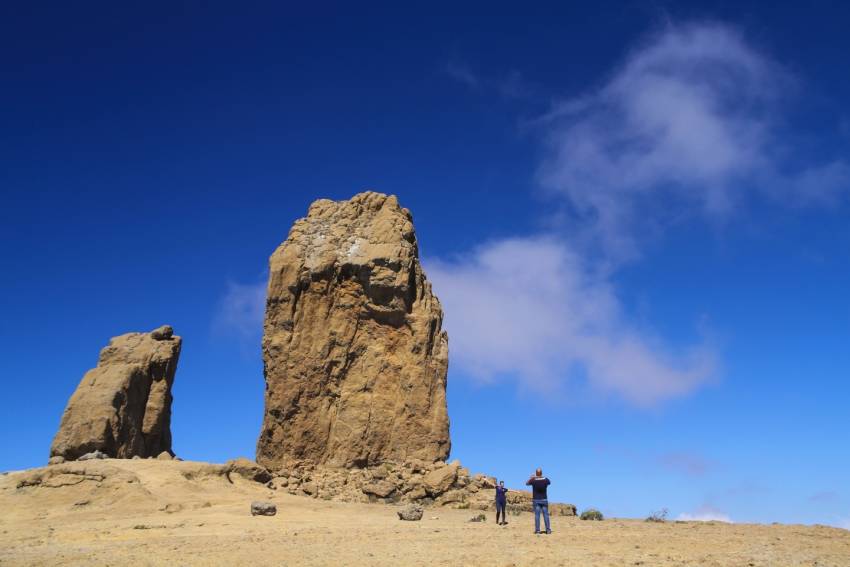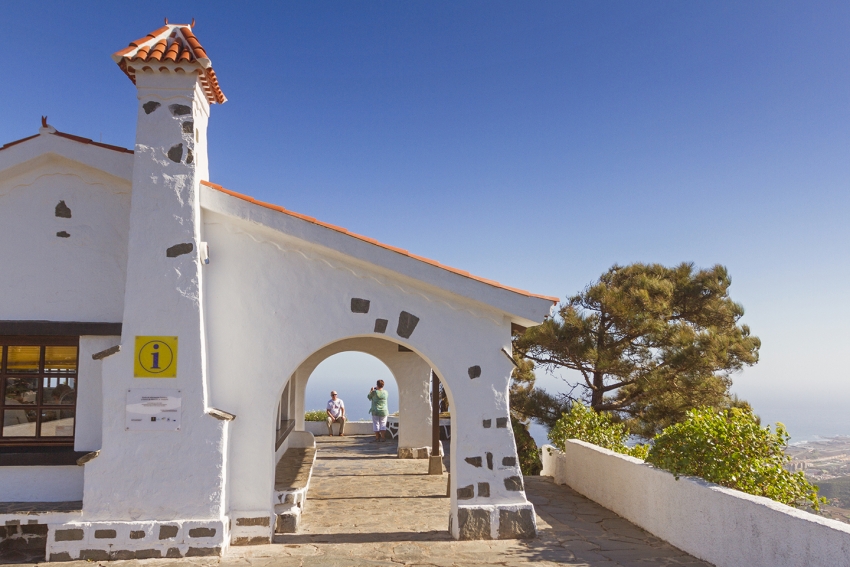Maspalomas dunes
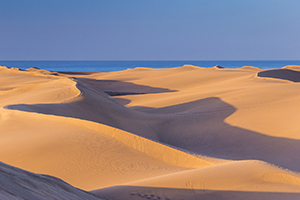 You have to visit the Maspalomas sand dunes if you're staying in south Gran Canaria. The island's little slice of the Sahara is a great spot for holiday snaps but take care in the hot sun, especially during the summer: the sand is hot and swallows shoes. Visit the dunes at dawn to have them all to yourself or go at sunset for stunning views with the sun disappearing behind the lighthouse. Or combine a visit with a day on the clothing optional beach where the dunes meet the sea.
You have to visit the Maspalomas sand dunes if you're staying in south Gran Canaria. The island's little slice of the Sahara is a great spot for holiday snaps but take care in the hot sun, especially during the summer: the sand is hot and swallows shoes. Visit the dunes at dawn to have them all to yourself or go at sunset for stunning views with the sun disappearing behind the lighthouse. Or combine a visit with a day on the clothing optional beach where the dunes meet the sea.
Roque Nublo
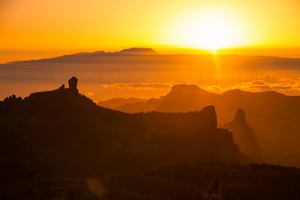 While you can see Roque Nublo from all over the highlands, you only appreciate its vast scale when you get up close: The rock is 65 metres tall. Hike up from the road and once you're on the platform you'll realise why it's the island's top icon. It's worth the extra effort to get right to the rock and see the view west towards La Aldea and Tenerife. You also get to scramble to the little platform just by the main rock for great photos with the whole of west Gran Canaria below you.
While you can see Roque Nublo from all over the highlands, you only appreciate its vast scale when you get up close: The rock is 65 metres tall. Hike up from the road and once you're on the platform you'll realise why it's the island's top icon. It's worth the extra effort to get right to the rock and see the view west towards La Aldea and Tenerife. You also get to scramble to the little platform just by the main rock for great photos with the whole of west Gran Canaria below you.
Roque Bentaiga
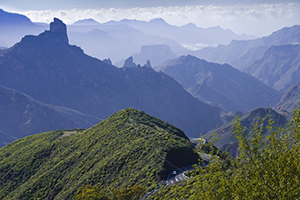 While Roque Nublo is the island's modern icon, the island's original inhabitants held Roque Bentaiga in more esteem. The rock is surrounded by caves, Canarii settlements and altars. Roque Bentaiga is every bit as spectacular as Roque Nublo but doesn't get the crowds.
While Roque Nublo is the island's modern icon, the island's original inhabitants held Roque Bentaiga in more esteem. The rock is surrounded by caves, Canarii settlements and altars. Roque Bentaiga is every bit as spectacular as Roque Nublo but doesn't get the crowds.
The area around the rock has lots of caves that make for great photos and is also rich in rare plants.
Guayadeque valley
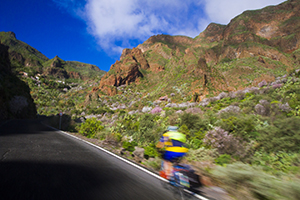 Sacred to the island's original Canarii inhabitants and a one of the main cave house áreas in Gran Canaria, Guayadeque is Gran Canaria's most interesting barranco. As well as the cave church and restaurant, it's a fantastic place for walking and is full or rare and unique plants.
Sacred to the island's original Canarii inhabitants and a one of the main cave house áreas in Gran Canaria, Guayadeque is Gran Canaria's most interesting barranco. As well as the cave church and restaurant, it's a fantastic place for walking and is full or rare and unique plants.
The Guayadeque valley is a great day trip from the south, especially if you combine it with Agüimes old town and maybe a swim at Arinaga.
Vegueta
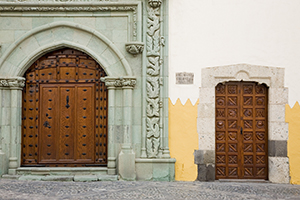 Old town Vegueta is the ultimate day-trip friendly cultural destination. It's small, compact and stuffed with things to do and see. Several are Gran Canaria icons in their won right but since you'll visit them during a trip to Vegueta we've put them all together.
Old town Vegueta is the ultimate day-trip friendly cultural destination. It's small, compact and stuffed with things to do and see. Several are Gran Canaria icons in their won right but since you'll visit them during a trip to Vegueta we've put them all together.
The Casa de Colon museum is all about Columbus' time in Las Palmas and his journey's across the Atlantic to America. It's set in a superb colonial mansion complete with internal courtyard.
The little Museo Canario is stuffed with Guanche and Canarii skeletons, mummies and pots. It's a great place to learn about the history of the island and has a replica of Galdar's Cueva Pintada.
 There are two ways to visit Santa Ana Cathedral: either go up to the roof from the front entrance in Santa Ana square, or visit the silver museum and the cathedral interior via the south wall. The museum is great if you're into art and history but the inside of Santa Ana, with its huge columns and vaulted ceiling decorated with stone latticework, is worth the entrance price alone.
There are two ways to visit Santa Ana Cathedral: either go up to the roof from the front entrance in Santa Ana square, or visit the silver museum and the cathedral interior via the south wall. The museum is great if you're into art and history but the inside of Santa Ana, with its huge columns and vaulted ceiling decorated with stone latticework, is worth the entrance price alone.
The CAAM art gallery is a huge space dedicated to modern art. It's set in an old Vegueta mansion and the exhibits change regularly. A great contract between the old building and the wide open spaces and modern art.
Dedo de Dios
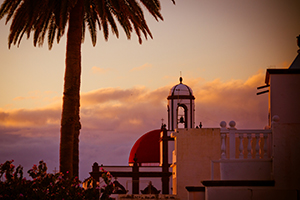 The Finger of God rock at Puerto de las Nieves didn't survive Tropical Storm Delta in 2005. The knuckle is still there when you look across the bay from the old jetty but its just not the same.
The Finger of God rock at Puerto de las Nieves didn't survive Tropical Storm Delta in 2005. The knuckle is still there when you look across the bay from the old jetty but its just not the same.
While the Dedo de Dios has lost its iconic status, you should till visit Puerto de las Nieves and the Agaete Valley. It's the perfect lunch stop on a drive around the island.
Las Canteras beach
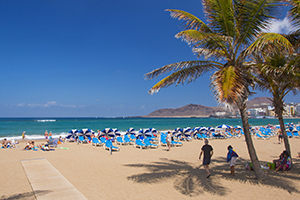 Even if you're in Las Palmas for shopping or culture, it's worth popping to the beachfront for a quick coffe or a leisurely lunch. Las Canteras is a spectacular urban beach and in the Tripadvisor Top Ten beachs in Spain. The great thing about Las Canteras is that you do anything on it from surfing big waves or swimming behind the reef to sunbathing under a coconut palm tree. If you visit Las Palmas, then you have to see its beach.
Even if you're in Las Palmas for shopping or culture, it's worth popping to the beachfront for a quick coffe or a leisurely lunch. Las Canteras is a spectacular urban beach and in the Tripadvisor Top Ten beachs in Spain. The great thing about Las Canteras is that you do anything on it from surfing big waves or swimming behind the reef to sunbathing under a coconut palm tree. If you visit Las Palmas, then you have to see its beach.
Güigüi beach
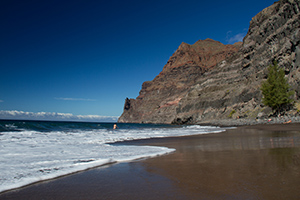 Güigüi beach is Gran Canaria's legendary isolated beach. Way out west, it's a long and spectacular walk from the road and you often get it to yourself. The sunset views are fantastic, but you have to sleep over to see them.
Güigüi beach is Gran Canaria's legendary isolated beach. Way out west, it's a long and spectacular walk from the road and you often get it to yourself. The sunset views are fantastic, but you have to sleep over to see them.
To walk to Güigüi, follow the trail from Tasartico hamlet, or get a boat trip from Puerto Rico marina.
Clothing at Güigüi beach is optional.
Bandama caldera
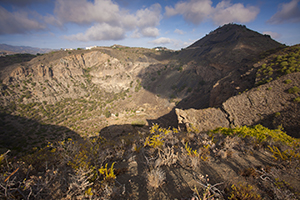 While the Bandama caldera is an impressive hole in the ground there's not much point just going to look at it: you drive up the cinder cone, look down at the Caldera, and then drive down again.
While the Bandama caldera is an impressive hole in the ground there's not much point just going to look at it: you drive up the cinder cone, look down at the Caldera, and then drive down again.
Bandama comes to life if you walk into the caldera or around its rim. Both walks have steep sections and the rim walk has sections with steep drop-offs on both sides.
Jardín Canario botanical garden
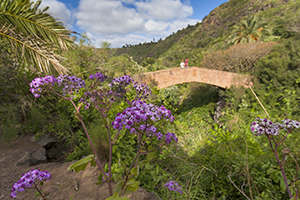 The Jardín Canario is Europe's biggest botanical garden and is full of exotic palms and cactus as well as weird and wonderful Canary Islands plants. Set in a deep ravine it's full of cliff paths, lakes, streams and forests. This vast garden is the Noah's Ark of the Canary Islands and exists to protect their 600 unique plants. As you walk its paths you see some of the world's rarest and most spectacular species.
The Jardín Canario is Europe's biggest botanical garden and is full of exotic palms and cactus as well as weird and wonderful Canary Islands plants. Set in a deep ravine it's full of cliff paths, lakes, streams and forests. This vast garden is the Noah's Ark of the Canary Islands and exists to protect their 600 unique plants. As you walk its paths you see some of the world's rarest and most spectacular species.
The beautiful Jardín Canario is a beautiful spot just 15 minutes from Las Palmas city and is a must-visit.
Cueva Pintada
Galdar's Cueva Pintada archaeological site is more than just a painted cave: it's an entire pre-Hispanic village that you can walk around and a great introduction to life on the Canary Islands before the Spanish arrived.
Puerto de Mogán
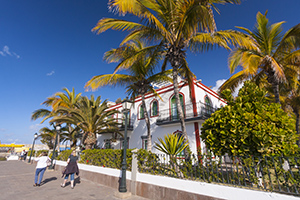 It's rare anywhere in the world for a tourist resort to become an icon, but Puerto de Mogán manages it with ease. The whitewashed houses and bougainvillea arches give it charm and the permanent blue sky makes it a sure-fire win. Puerto de Mogán is still a fishing village at heart.
It's rare anywhere in the world for a tourist resort to become an icon, but Puerto de Mogán manages it with ease. The whitewashed houses and bougainvillea arches give it charm and the permanent blue sky makes it a sure-fire win. Puerto de Mogán is still a fishing village at heart.
Visit for a walk around the marina and lunch by the sea, then go to golden Mogán beach or climb up to the viewpoint behind the village.
Teror
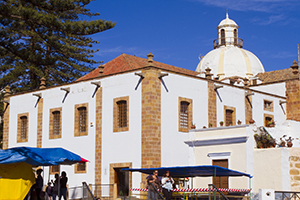 Everyone visits Teror on Sunday for the market but the town is just as pretty and much less crowded during the week. The church is the highlight but there's plenty of squares and cobbled lanes to keep you busy for an hour or two. The island's patron saint, the Virgen del Pino, is inside the church but please be respectful (wear a shirt, don't photograph locals at prayer, turn off your flash, etc).
Everyone visits Teror on Sunday for the market but the town is just as pretty and much less crowded during the week. The church is the highlight but there's plenty of squares and cobbled lanes to keep you busy for an hour or two. The island's patron saint, the Virgen del Pino, is inside the church but please be respectful (wear a shirt, don't photograph locals at prayer, turn off your flash, etc).
If you like garlic, try the town's famous chorizo de Teror.


